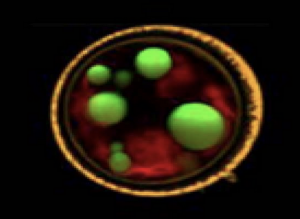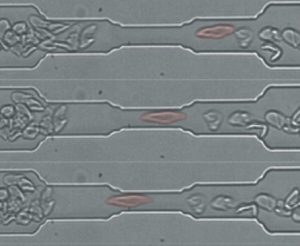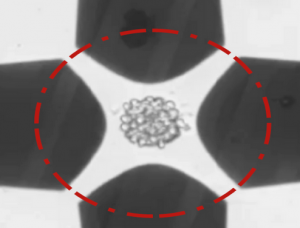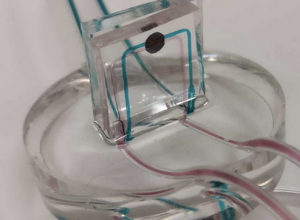Fluidic and electric microsystems for life science studies
Microfluidic devices have the good scale to perform electrical, photonic or plasmonic experiments on single cells, cell tissues, or to perform parallel biochemical assay. This theme is divided into two actions:
- Bio-Microfuidic Systems
- Droplet-based microfluidics systems:
1. Bio-Microfuidic Systems
The electric field induces changes not only in the plasma membrane of cells (electroporation), but also affects its intracellular content. Microfluidic devices are used for the real time monitoring of those effects. We develop devices for the treatment of cells (single cells or cell tissues), or for the characterization of cells and cell components (membrane, intracellular content). More details on this activity
Biodevices for the monitoring and the treatment of micro-algae:
Microalgae are producing intracytoplasmic lipid droplets, which is a potential biofuel source. We investigate in our group the application of electrical and/or mechanical treatments, and their effects on the membrane and wall of the micro-organism, at the level of the single cell, using therefore specific microfluidic systems More details
Biodevices for the red blood cells sensing:
We develop devices for the mechanical and electrical sensing of the rigidity of red blood cells. Genetic diseases like the sickle cell disease or spherocytosis disease, or infectious diseases like malaria, affect the rigidity of the red blood cells. Microfluidic devices , equipped with sensing electrodes, are capable to characterize and discrimitate the different levels of the disease. More details
Cell trapping and treatment with the electrical field:
We work on the fabrication and design of microfluidic devices playing with the electric field, in order to handle and/or apply treatments on cells. Cell electroporation, or nanoporation is investigated on a chip. Electrorotation is also used, for cell content or organoid content sensing. More details
Bio-mimicking microfluidic devices:
We propose microfluidic devices capable to reproduce the structure and functions of the spleen, or more recently reproducing functions of the liver lobule (organ on chip). Besides, the group works on the microfluidic integration of biological or biomimicking solid-state nanopores, for the biosensing. More details
2. Droplet-based microfluidics systems:
allows for the production and the manipulation of highly monodisperse microdroplets of fluids, each of those being an independent microreactor, enabling highly sensitive (bio)chemical assays. Such “digital” optofluidic micro-systems can be used in many areas, including biological membrane studies, biosensing, artificial photosynthesis or nanophotonics.











